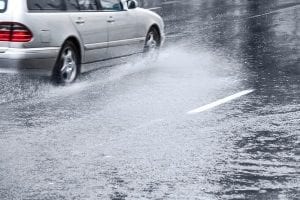Spring weather in Connecticut is known to have a significant impact on roadways and traveling conditions, causing bad weather accidents. But can weather affect your car accident claim? The answer is yes, though, it depends on a few factors.
Of course, it is always important to be cautious and alert every time you get behind the wheel. This caution is especially important when severe weather conditions come into play. Every year, there are more than 5,748,000 vehicle crashes, according to the U.S. Department of Transportation.
There are more than 1,200,000 weather-related accidents every year, according to the U.S. Department of Transportation.
Auto Accidents During The Spring
If you or a loved one has already been involved in a wreck due to unseasonable spring weather, contact The Flood Law Firm today by calling (860) 346-2695.

Depending on the circumstances surrounding your claim, you may benefit from having an advocate on your side. Our professional team of attorneys has decades of combined experience to offer you the legal assistance you need to move forward with your life. We guarantee a smooth, convenient process, allowing you to focus on your personal healing and recovery.
Spring Weather Accident Statistics
While accidents take place during all four seasons of the year, spring months often create more risks on roadways, usually leading to a higher rate of wrecks. The following statistics from the Federal Highway Administration illustrate just how dangerous snowy and icy roads can be:
- Over 70 percent of the nation’s roads are in snowy regions, and receive more than five inches of snowfall annually on average.
- Almost 70 percent of the United States’ population lives in these snowy regions.
- More than 1,300 people die annually with another 116,800 injured in vehicle crashes due to snowy, slushy, or icy roadways.
- Nearly 900 people are killed, with another 76,000 injured in automobile accidents each year in snow or sleet storms.
- Twenty-four percent of weather-related vehicle crashes take place on snowy, icy, or slushy roadways, with another 15 percent occurring while it’s snowing or sleeting.
- Freeway speeds are reduced by 3 to 13 percent in light snowfall, and by 5 to 40 percent in heavy snowfall.
- Average speeds on non-highway roads decline by 30 to 40 percent when pavements are sullied with snow, sleet, or slush.
- Winter and spring road maintenance account for nearly 20 percent of the state Department of Transportation maintenance budgets.
Bottom line: when spring months hit, be extra cautious on the road. When the weather is particularly dangerous, follow local news for weather and travel updates and be sure to observe all travel restrictions.
Types of Spring Weather

When most drivers think of spring weather, they imagine rain. But rain is not the only kind of hazardous spring weather. There are more categories of bad weather that occurs during the springtime.
Rain
From drizzles to light rain and violent downpours, rain can be dangerous in all its various forms. Freezing rain can make traveling treacherous, as roads are no longer just slippery, but coated with ice.
Black Ice
When rain or snowmelt freezes on pavement, it forms ice on the roads that is often referred to as “black ice.” Black ice is almost always hard to spot, and can also form if the road is not designed or maintained well enough to drain properly. It is particularly harmful near bridges and overpasses, as temperatures tend to drop more rapidly on elevated surfaces. Drivers should slow down and drive well under the speed limit since this ice isn’t always visible. If you’re driving during a time when you might encounter black ice, make sure to check your tire tread for traction, drive slowly, and always use your headlights.
High winds
Strong winds alone are sometimes enough to blow debris into roadways and make vehicles – especially larger ones – harder to control and prone to rollovers. Couple this with rain, snow, or sleet, and the conditions could be disastrous.
Other types of spring weather you should be aware of include sleet, wind chill conditions, and below-freezing temperatures that can be life-threatening if you experience a vehicle break down and are stranded outdoors.
During Extreme Spring Weather
Most car accidents can be prevented. While there are circumstances that cannot always be avoided, it’s important to make sure you’re doing your part to help promote road safety.
When spring weather becomes particularly dangerous, consider these tips:
Don’t Drive
It’s easier said than done, but consider your destination and whether traveling is absolutely necessary. If you are heading to work, consider making other arrangements with your boss over the phone or via email. If you don’t have to be on the road, then stay off it. If you are already out when a storm begins, remember that pulling over to a safe area is also an option.
Upgrade Your Tires
Though this will take some planning, be sure to upgrade your vehicle with appropriate tire chains or snow tires. Depending on your location, upgrading your tires should be a priority, especially if you travel often during the spring months or have a long commute.
Increase Visibility
To be safe on the road during spring weather, you will need to be as alert as possible. Therefore, increasing your visibility is imperative. Clear snow off all windows, as well as your windshield, and make sure your wipers are in good condition. Never leave home without an ice-scraper, and always check to see if you’re running low on windshield wiper fluid.
Slow Down
No matter the speed limit – if the weather is bad, slow down. If you start to slide, consider pulling over but avoid slamming on your breaks.
Stay Calm
Driving in intense weather can be scary. You may feel panicked or aggravated, but staying calm will help ensure that you make smart, safe decisions.
Driving During Travel Ban
Remember that while travel restrictions issued by the state may be requests, you could also be fined if you are not considered an “essential employee” at your workplace and are pulled over by state officials during a storm.
When a driver gets on the road during a state of emergency or travel ban, the car insurance carrier should still cover a resulting car wreck according to its limits. Even though this behavior may be classified as a negligent action, car insurance companies must cover most damages arising from collisions that occur during the travel ban. Noteworthy exceptions are specific policy exclusions for off-roading. Be sure to carefully review your insurance policy to find out more about such exclusions.
Continue reading about Car Accident Negligence here.
Contact a Connecticut Attorney Today
If you or a loved one has been involved in an accident due to poor weather conditions, The Flood Law Firm is ready to be your advocate. Our professional team of attorneys has the knowledge and skills to assess your case and can help you move on with your life. Whether you need assistance due to an uncooperative insurance provider or are having difficulty determining fault for the wreck, our firm can provide expert advice.
Contact us today by calling (860) 346-2695 for a no-cost, no-obligation consultation.
